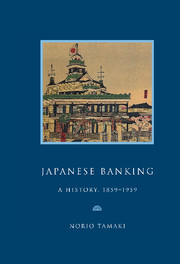Book contents
- Frontmatter
- Contents
- Preface
- Genealogy of leading Japanese banks, 1859–1959
- List of abbreviations
- Map
- Part I A bankrupt Shogunate, 1859–1868
- Part II The Meiji Restoration: monetary confusion and banking experiments, 1868–1881
- Part III Matsukata, the wizard of Japanese banking, 1881–1897; the Yokohama Specie Bank (1880) and the Bank of Japan (1882)
- Part IV The Japanese on the London money market, 1897–1911
- Part V War, the Japanese boom years, 1911–1919
- Historical background
- 17 Bank of Japan money supply, 1911–1919
- 18 The expansion of special banking, 1911–1919
- 19 Ordinary and savings banks, the search for strength, 1911–1919
- 20 Other financial sectors in the boom years, 1911–1919
- Part VI Crisis and the road to war, 1919–1937
- Part VII Complete commitment, struggle and defeat, 1937–1945
- Part VIII American ‘democratisation’ and the search for growth, 1945–1959
- An extraordinary century, 1859–1959
- Appendices
- Notes
- Bibliography
- Index
18 - The expansion of special banking, 1911–1919
Published online by Cambridge University Press: 03 February 2010
- Frontmatter
- Contents
- Preface
- Genealogy of leading Japanese banks, 1859–1959
- List of abbreviations
- Map
- Part I A bankrupt Shogunate, 1859–1868
- Part II The Meiji Restoration: monetary confusion and banking experiments, 1868–1881
- Part III Matsukata, the wizard of Japanese banking, 1881–1897; the Yokohama Specie Bank (1880) and the Bank of Japan (1882)
- Part IV The Japanese on the London money market, 1897–1911
- Part V War, the Japanese boom years, 1911–1919
- Historical background
- 17 Bank of Japan money supply, 1911–1919
- 18 The expansion of special banking, 1911–1919
- 19 Ordinary and savings banks, the search for strength, 1911–1919
- 20 Other financial sectors in the boom years, 1911–1919
- Part VI Crisis and the road to war, 1919–1937
- Part VII Complete commitment, struggle and defeat, 1937–1945
- Part VIII American ‘democratisation’ and the search for growth, 1945–1959
- An extraordinary century, 1859–1959
- Appendices
- Notes
- Bibliography
- Index
Summary
The Yokohama Specie Bank and foreign trade financing, 1911–1919
The Yokohama Specie Bank enlarged its commitments nearly fourfold in terms of total liabilities/assets from ¥378.3 to ¥1,465.6 million between 1914 and 1919. On the assets side, the figures of buying bills and interest bills grew remarkably from ¥135.2 and ¥36.6 million to ¥538.1 and ¥165.1 million respectively. The growth rates during these five years were 431 per cent and 451 per cent respectively. The aggregate amount for the two items, symbols of foreign trade financing of the Specie Bank, was well over half of the total assets. On the liabilities side, deposits grew by nearly three times to ¥516.6 million. Rediscounting facilities at the Bank of Japan also increased at the same rate to ¥136.1 million. However, in both relative and absolute terms, the growth of inter-bank borrowing was most remarkable, jumping from ¥54.2 to ¥456.3 million from 1914to 1919.
It was during these hectic years of 1914 to 1919 that the overseas branch network of the Specie Bank reached maturity. Between 1914 and 1919, the number of branches increased from twenty-three to thirty-six, of which six were in Japan and thirty were overseas. Of these overseas branches fourteen were on the Chinese mainland, including seven in Manchuria, six in the western countries, two in South America, five in the Straits of Malaya and Australia and three in India. There were no branches in Africa. By far the most important branch was that in London, which handled extensive inter-bank borrowing.
- Type
- Chapter
- Information
- Japanese BankingA History, 1859–1959, pp. 118 - 125Publisher: Cambridge University PressPrint publication year: 1995



